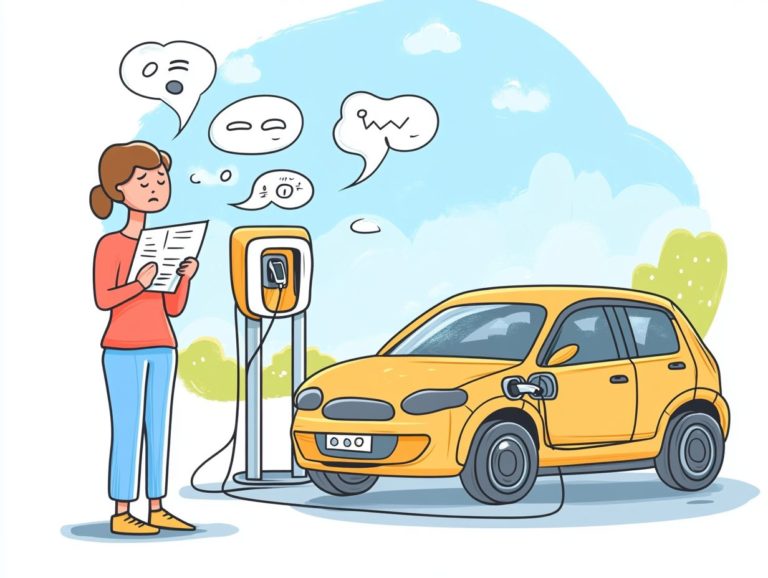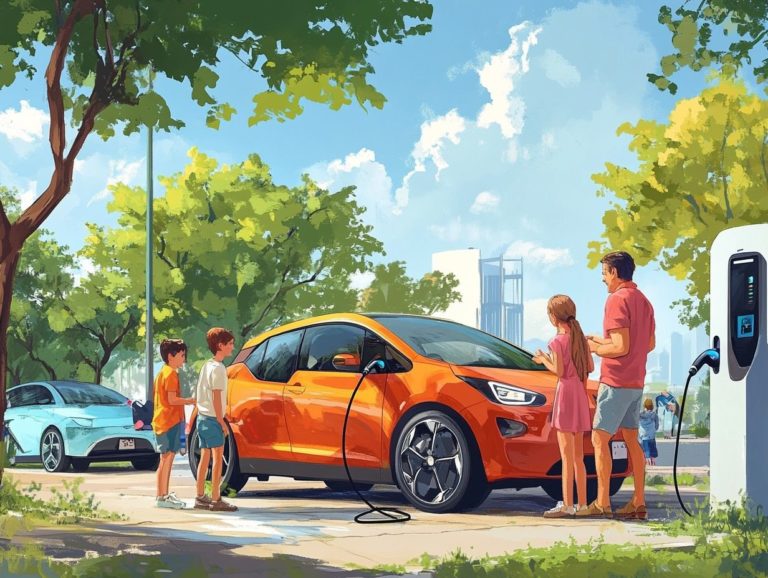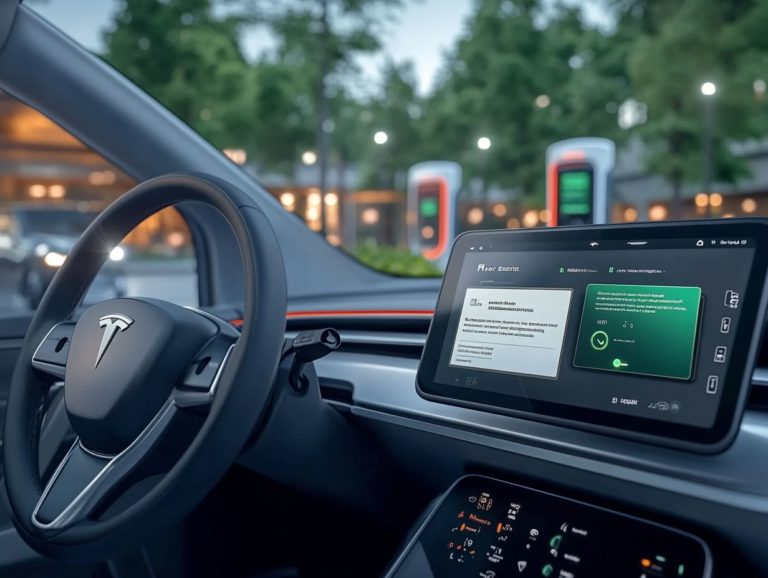What to Know About EV Safety Ratings
Electric vehicles (EVs) are transforming your perspective on transportation. But how safe are they really?
Understanding EV safety ratings is vital for anyone seeking to make informed decisions. This article delves into what EV safety ratings entail, covering the different types, including crash test results and safety feature assessments. It also explores the factors that influence these scores.
You will learn how to interpret these ratings effectively. Discover how manufacturers can elevate safety standards. Dive into the essential elements of EV safety ratings and drive with confidence!
Contents
- Key Takeaways:
- Overview of EV Safety Ratings
- Types of EV Safety Ratings
- Factors that Affect EV Safety Ratings
- How to Interpret EV Safety Ratings
- Improving EV Safety Ratings
- Frequently Asked Questions
- What to Know About EV Safety Ratings?
- What factors are considered in EV safety ratings?
- How are EVs tested for safety?
- Are EVs safer than traditional vehicles?
- What are some common advanced safety features found in EVs?
- Do all EVs have the same safety ratings?
- How can I find the safety ratings for a specific EV model?
Key Takeaways:

- Understanding EV safety ratings is crucial for making informed decisions about purchasing an electric vehicle.
- Factors such as vehicle design, technology, and government regulations impact EV safety ratings.
- To improve EV safety ratings, manufacturers need to prioritize safety features. Consumers also need to educate themselves on how to interpret ratings.
Overview of EV Safety Ratings
The growing appeal of electric vehicles (EVs) has ignited a dialogue about their safety ratings. This is especially important as you weigh the environmental benefits of your choices against the safety of yourself and your loved ones.
Organizations like Euro NCAP and the Insurance Institute for Highway Safety have established thorough testing protocols for electric cars. They assess safety features and crashworthiness across a range of models, including the Genesis Electrified G80 and Tesla Model Y.
As hybrid-electric and battery-electric vehicles become key players in the automotive scene, grasping these safety ratings is crucial for making informed decisions.
What are EV Safety Ratings?
EV safety ratings represent comprehensive evaluations that assess how electric vehicles perform in crash tests and their overall safety features. These ratings offer essential insights for both consumers and manufacturers.
Leading organizations determine these ratings using clear criteria. They analyze factors like occupant protection, child safety, pedestrian safety, and the effectiveness of features that help drivers with tasks like parking and avoiding accidents.
The total score is derived from performance in various tests, including frontal impacts, side crashes, and rollover tests. High safety ratings enhance protection for occupants and promote more sustainable vehicle designs by influencing emissions through the use of eco-friendly materials and technologies.
This dedication to safety in electric vehicles means they serve as more than just greener options. They are equipped with robust safety measures that foster consumer confidence and encourage broader adoption.
Types of EV Safety Ratings
EV safety ratings fall into two primary categories: crash test ratings and safety features ratings. Each of these is essential for assessing the overall safety of electric vehicles, ensuring you make informed decisions about your next ride.
Crash Test Ratings
Crash test ratings serve as a vital benchmark for understanding how electric vehicles fare in collision scenarios. Organizations like Euro NCAP and the Insurance Institute for Highway Safety conduct rigorous evaluations, assessing vehicles such as the Tesla Model 3 and Hyundai Ioniq for their pedestrian front-crash capabilities.
These assessments employ a range of methodologies, including front offset collisions, side impact tests, and rear-impact evaluations. Each method is designed to mimic real-world conditions. Metrics such as structural integrity, occupant safety, and the effectiveness of pedestrian safety features are meticulously evaluated during these tests.
This focus on pedestrian safety has gained significant traction as manufacturers strive to enhance front-end designs to reduce injuries among vulnerable road users. Take the Hyundai Ioniq, for example; it has demonstrated commendable performance in these areas, earning high scores in pedestrian impact tests.
The Tesla Model 3 also boasts impressive ratings, positioning both vehicles as standout options for safety-conscious consumers.
Safety Features Ratings

Safety feature ratings evaluate the advanced technologies embedded in electric cars designed to enhance occupant protection and prevent accidents. Organizations like Euro NCAP meticulously assess elements such as braking systems and driver assistance features. This provides invaluable insights.
These evaluations consider crucial components like braking systems that recover energy, which boost efficiency and deliver extra stopping power during emergencies. Driver assistance technologies, including lane-keeping assistance and adaptive cruise control, play a pivotal role in reducing human error one of the primary culprits behind accidents.
By incorporating these features, manufacturers prioritize your safety, which is crucial on today’s busy roads. Regular updates and evaluations of these systems can significantly diminish the chances of failures. Dependable access to charging stations enhances your overall vehicle readiness, allowing you to hit the road with confidence.
Factors that Affect EV Safety Ratings
Several key factors influence EV safety ratings that are important to consider. These include the vehicle’s design and technology, compliance with government regulations, and standards established by organizations like Euro NCAP and the Insurance Institute for Highway Safety.
Vehicle Design and Technology
The design and technology of electric cars are crucial in shaping their safety ratings. With advancements in materials and systems, such as lithium-ion chemistry and battery management systems, you ll find enhanced crash performance and improved occupant protection.
Innovative features like crumple zones absorb impact forces, significantly reducing the risk of injury to passengers during collisions. The strategic placement of batteries improves weight distribution and handling while ensuring they are well-protected in the event of an accident.
The integration of advanced driver-assistance systems (ADAS) is another key element. These systems are designed to proactively prevent accidents through features like automatic braking and lane-keeping assistance. Organizations such as Euro NCAP rigorously test and evaluate these technologies to provide valuable safety ratings for consumers.
Government Regulations and Standards
Government regulations and standards are pivotal in shaping the safety landscape for electric vehicles. They establish the minimum requirements that manufacturers must meet to ensure the safety and reliability of their products.
Guidelines set by organizations like the National Highway Traffic Safety Administration define the parameters for vehicle design, performance, and safety features. By mandating rigorous testing and compliance, these agencies hold manufacturers accountable and foster a culture of transparency and reliability within the EV market.
As manufacturers adhere to these standards, they cultivate consumer trust. This enables potential buyers to feel more confident in their investment. Ultimately, the symbiotic relationship between regulatory bodies and manufacturers enhances the overall safety of electric vehicles and reinforces public acceptance of this innovative mode of transportation.
How to Interpret EV Safety Ratings
Interpreting EV safety ratings requires a keen understanding of the scoring systems employed by esteemed organizations such as Euro NCAP and the Insurance Institute for Highway Safety. These organizations utilize a star rating system to communicate the safety performance of electric vehicles effectively, offering valuable insights that can guide your decisions.
Understanding the Scoring System

The EV safety rating system provides a clear framework to help you make informed purchasing decisions. Organizations like Euro NCAP and the Insurance Institute assign points based on various safety features.
This system evaluates critical components, including crash protection, pedestrian safety, and advanced driver-assistance systems (ADAS), which help prevent accidents. The Tesla Model, for instance, has garnered impressive scores due to its robust structural integrity and innovative features like Autopilot, significantly enhancing its safety profile.
The Genesis Electrified shines with its comprehensive suite of safety technologies, including automatic emergency braking and lane-keeping assist. These features contribute to its high rating. Understanding how these ratings work empowers you to make smart choices that keep you safe on the road!
Improving EV Safety Ratings
Enhancing EV safety ratings requires manufacturers to engage in a dedicated effort. They must refine vehicle designs, integrate cutting-edge EV technology, and foster consumer awareness regarding safety features.
By prioritizing these aspects, you can significantly contribute to a safer driving experience for everyone.
Steps Manufacturers Can Take
You can enhance EV safety ratings by embracing cutting-edge technology and refining safety features that meet the standards set by Euro NCAP and the Insurance Institute.
Consider integrating advanced safety systems such as automated emergency braking, lane-keeping assistance, and collision avoidance technologies. These features elevate vehicle protection and meet the evolving expectations of today s consumers.
Conduct extensive crash tests across various real-world scenarios to ensure reliability and robustness. This helps identify potential vulnerabilities early in the design phase.
Sharing data with safety organizations and engaging transparently with consumers builds trust and confidence in your vehicles. This proactive approach boosts consumer faith in your brand, enhances market competitiveness, and leads to increased sales and enduring brand loyalty.
Consumer Education and Awareness
Consumer education and awareness are crucial for maximizing the benefits of EV safety ratings. This allows you to make informed choices about the safety features and technology in electric vehicles.
Understanding the intricate details of safety ratings enables you to identify which models are truly the safest. It also helps you grasp the importance of certain safety features in reducing risks. Manufacturers and organizations could launch educational campaigns that simplify complex safety standards.
Utilizing platforms like social media, webinars, and community workshops can effectively reach you. By showcasing real-world scenarios and the tangible benefits of advanced safety features, these initiatives foster a culture of safety consciousness among consumers.
Such efforts will bolster your confidence as a buyer and enrich public discourse on the ever-evolving landscape of electric vehicle reliability. Dive into available resources to discover which EVs are the safest for you!
Frequently Asked Questions
What to Know About EV Safety Ratings?

Electric vehicles (EVs) are becoming more popular, and with that comes questions about their safety. Here are some frequently asked questions about EV safety ratings.
What factors are considered in EV safety ratings?
EV safety ratings consider crash test results, handling, braking performance, and advanced safety features.
How are EVs tested for safety?
EVs undergo the same rigorous safety testing as traditional gasoline-powered vehicles. This includes front, side, and rollover crash tests, as well as evaluations of advanced safety features.
Are EVs safer than traditional vehicles?
It depends on the specific model. Generally, EVs have similar or better safety ratings compared to traditional vehicles, thanks to their advanced safety features and innovative design.
What are some common advanced safety features found in EVs?
EVs often include features like forward collision warning and automatic emergency braking.
They also come with blind spot detection and lane departure warning, which help prevent accidents.
Do all EVs have the same safety ratings?
No, safety ratings vary among different EV models, just like traditional vehicles. Researching and comparing ratings is crucial when considering an EV purchase.
How can I find the safety ratings for a specific EV model?
You can easily discover safety ratings for specific EV models on trusted websites like the National Highway Traffic Safety Administration (NHTSA) or the Insurance Institute for Highway Safety (IIHS).
Checking the manufacturer’s website is also a great way to get detailed safety information.






